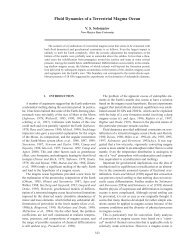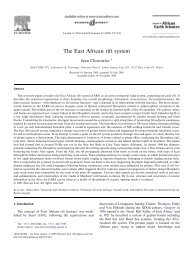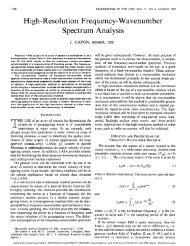Directional Recording of Swell from Distant Storms - Department of ...
Directional Recording of Swell from Distant Storms - Department of ...
Directional Recording of Swell from Distant Storms - Department of ...
You also want an ePaper? Increase the reach of your titles
YUMPU automatically turns print PDFs into web optimized ePapers that Google loves.
DIRECTIONAL RECORDING OF SWELL FROM DISTANT STORMS 571been continuous throughout the month. Evidently the flank <strong>of</strong> the mean monthly spectrumis closely related to the energy along individual ridges (figure 40) but a more detailed comparisonshows that the rise is steeper for the individual ridges (figure 43).The sharp rise in the spectrum tapers <strong>of</strong>f at 50 c/ks, and the spectra] level becomes nearlyflat between 75 and 90 c/ks. At even higher frequencies the spectrum is known to rise onceagain as a result <strong>of</strong> waves generated in nearby wind systems. In figure 44 we have portrayedwhat we believe to be the typical situation. The curve marked 'distant generation' is crudelyrepresentative <strong>of</strong> the type <strong>of</strong> spectra one might expect in the generating area. Above 50 c/ksthe observed spectra fall below the expected generation spectra, and this indicates the importance<strong>of</strong> decay processes at these higher frequencies.15. SCATTER AND ABSORPTIONThe physical processes leading to attenuation are unknown. The direct effect <strong>of</strong> molecularviscosity is negligible. The last few years have seen a rapid development in the study <strong>of</strong> nonlineareffects on wave motion; wave-wave interactions and wave-turbulence interactionhave received particular attention. In general such interactions lead to the scattering <strong>of</strong>the incident wave energy into waves <strong>of</strong> different lengths and/or direction. Such interactionsapply to the present study in a number <strong>of</strong> ways: forward scattering broadens the beam andaugments the spectral peaks on the low-frequency side; backward scattering reduces theenergy received at the station; scattering into high wave numbers permits molecular processesto become effective and thus ultimately leads to destruction <strong>of</strong> wave energy. The interactionsare weak and difficult to demonstrate on a laboratory scale. The present measurementsrefer to the propagation <strong>of</strong> swell over i04 wavelengths.(a) The evidence(i) Attenuation (apart <strong>from</strong> the effect <strong>of</strong> geometric spreading) appears to be small atfrequencies below 50 c/ks and predominant above 60 c/ks. This is evident both <strong>from</strong> individualridge cuts (figure 40) and the monthly spectra (figure 41). In general the spectralevel <strong>of</strong>f at some fixed energy density. This suggests that the absorptive processes may beselective against the high energy rather than the high frequency. If the absorption werefrequency controlled, we should expect the spectral peaks to be slightly shifted towardslower frequencies and accordingly the ridges lines would ultimately curve to the right.Yet there is no measurable deviation <strong>from</strong> straight lines. There is no substantial broadening<strong>of</strong> the ridge with increasing frequency (figure 45), so that the conclusion would have beensimilar had we plotted total energy under the ridge rather than energy density at the crest<strong>of</strong> the ridge.(ii) The decay following the ridges is best studied by a series <strong>of</strong> cuts at fixed frequencies(figure 46). The energy rises rapidly to the summit and then decays gradually. For example,during 5 to 7 September at 50 c/ks, the energy rose by a factor <strong>of</strong> 30 in 1 day, then decayed bya factor <strong>of</strong> 1 0 per day for the next 2 days. On 17 September at 45 c/ks the decay by a factor 10takes place in 0 7 day. The most rapid decay is associated with the event <strong>of</strong> 12-4 May(factor <strong>of</strong> 10 in 0 4 day), but this appears to be an exceptional case (? 1 1 (c) ). We shall take2 day as the typical decay time, i.e. the time for the energy to decay by a factor e. The direction<strong>of</strong> the optimum point source remains fairly constant during the decay though there
















